|
ELECTRICITY...
it’s a numbers game.
Whether you are considering the
purchase of a solar power
system or trying to ascertain
why your power bill reads as it does, it’s a good idea to understand
some of the very basic math
about electricity usage and
costs. Not every
utility bill reads the same, but the gist of it is similar.
It will tell you how many
kilowatt-hours you have used in that billing period.
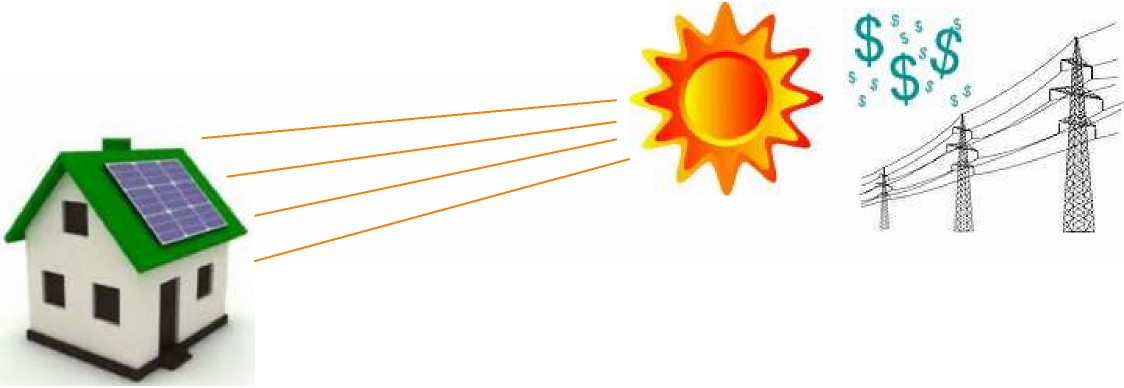
Some will give
you the number of days in your
billing period, then give you a total kilowatt-
hours used that month (so you
will have to divide the number of kilowatt-hours by the number of
days to get your kilowatt-hours per day that you are using).
A kilowatt-hour (kWh) is
1000 watt-hours; if you run ten 100W light bulbs for 1 hour, you
will have used up one
kilowatt-hour’s worth of electricity. Or, check out this chart for
some commonly used devices.
|
Appliance |
(Load)
Watthours |
Runs
Hrs/Day |
Uses
kWh/Day |
Uses
Watthours/day |
|
21cf
Refrigerator*
Efficient Fridge*
1500w Microwave
Incandescent
Light
8w LED Light
16w CFL Light
50" LCD Plasma TV
Satellite Box
15" Laptop
Phone Charger |
285
150
1500
100
8
16
150
95
65
23 |
8
8
0.5
3
3
3
6
24
8
4 |
2.28
1.20
0.75
0.30
0.024
0.048
0.090
2.28
0.52
0.092 |
2280
1200
750
300
24
48
900
2280
520
92 |
*Note: these numbers are to
give consumption examples; refrigerators do cycle, and do not run
continuously.
If you add up all of these loads, you come up with 8394 watt-hours
or 8.394kWh per day.
The average American household uses around 30 to 35 kWh or 30,000 to
35,000 watt-hours a day. An efficient home might use as little as 3
to 5 kWh per day (or 3,000 to 5,000 watt-hours); some of our
customers with all-electric homes and central air conditioning might
use as much as 120+ kWh per day – adding up to a very hefty utility
bill! That is why we, as system designers, encourage you to become
as electrically efficient as possible. It will save you BIG bucks in
the cost of your power system investment.
|
If you want to offset part or all of your utility bill, we will want
to know how much power you wish to
generate. If you are building an
off-grid home, we will need to know how many watt- hours a day, on
average, your system
needs to provide. A lot of folks just don’t
want to do the math, though. They’ll say, ”We are building a 2,000
sq. ft. home...” and figure that’s all the information we need. Just
to be funny, sometimes we will say, “What color is it?” And they’ll
say... ”Why does that matter?” – and then we say, well, it doesn’t
matter, just like it doesn’t matter how big it is, either; it’s how
much power you use. Some people are energy hogs and some are energy
frugal, so the same sized home might have very, very different power
requirements. Ultimately, we do need you to do some number-crunching
for us. If we oversize your system, it will cost more than
necessary, and if we undersize it, it won’t run what needs to be
powered. For a remote or off-grid home, the electrical load
information is square one to determine the size, components, and
cost of the power system. |

Kilo - what? |
If you are hooked up to utility power, but only want to run certain
loads in the event of a power outage, then we will need to know the
power requirements of those loads, and how many days of battery
back-up are desired. And figuring out the amount of battery back-up
is yet another numbers game! Here at the home office of Oasis
Montana, we have a battery-based, grid-tied power system. In summer,
when the sun is shining, we can run our house loads, including a 1.5
HP 240VAC pump – and we can still be feeding back power to our local
utility, Northwestern Energy (NWE). And when the power goes out, we
are generally not aware of it! So during the summer months, we
accrue a credit with NWE, and then over winter (when many of our
electrical loads are greater, and the available sunlight much less),
we use up that credit instead of adding to it. Last winter (2014
into 2015) we were able to make our ‘credits’ last through the
winter. But spring of 2015 brought us additional electrical loads
that made us much less efficient last year: we raised a
batch of baby chicks.
 |
They don’t stay ‘cute little chicks’
for long, and rapidly turn into dirty little birds. |
 |
|
 
 
SOLAR MODULE PRICING—Call
for availability, freight costs, and
quantities (# of modules) on pallets for the best deal. You can’t
get less than a
pallet quantity to get the pallet ‘deal.’ For larger modules, pallet
quantity
generally runs between 20 and 56 modules, and often there are
significant
additional charges for less (or more) than even pallet quantities.
Some suppliers
charge re-boxing fees too.
|
Module |
Single / Pallet / Qty |
|
LG280 Neon
280W, 9.07A, 31.4V
(64.57” X 39.37”) |
$439 |
$407 |
(27) |
|
Made in
South Korea
|
|
|
|
|
PHONOSOLAR,
PS260M, .93A, 240VAC
(64.6” x 39.1”) |
$529 |
$489 |
(18) |
|
Made in
China, monocrystalline AC module with Enphase Microinverters |
|
|
|
|
TRINA
TSM-PD14/305W, 8.25A, 33.3V
(77” x 39.05”) |
$349 |
$323 |
(24) |
|
Made in
China; multi crystalline |
|
|
|
|
SILFAB
SLA-270, 270W, 31.2V, 8.56A
(38.97” x 64.96”) |
$359 |
$334 |
(35) |
|
ARRA
Compliant |
|
|
|
|
SOLARWORLD
SW285W, 9.2A, 31.3V
(39.4” x 65.94”) |
$420 |
$389 |
(30) |
|
Made in
the USA or Germany; monocrystalline |
|
|
|
|
CANADIAN SOLAR,
255W, 30.1V, 8.4A
(64.5” x 38.7”) |
$329 |
$315 |
(24) |
|
Made in
China; polycrystalline |
|
|
|
PHONOSOLAR
PS260M 260W,30.8V,8.46A
(64.6” x 39”) |
$369 |
$339 |
(24) |
Made in
China; monocrystalline
|
|
|
|
PHONOSOLAR
PS290P, 290W, 8.03A,36.1V
(65” x 39.1”) $409 |
|
$399 |
(22) |
Made in
Taiwan & eastern Europe; polycrystalline
|
|
|
|
|
SUNIVA
270W, 31.2V, 8.6A (38.66” x 65.07”) |
$389 |
$352 |
(25)
|
|
Buy
American Compliant—cells made in the U.S., assembled in
China
|
|
|
|
|
KYOCERA
245GX, 245W, 8.23A, 29.8V
(64.5” x 39”)
|
$399 |
$359 |
(20) |
|
KYOCERA
140GX, 140W, 7.91A, 17.7V (59.1” x 26.3”)
|
$339 |
$299 |
(20) |
Sunwize SW-S30P, 30W, 17.4V, 1.72 A
(21.38" X 20.04")
|
$105 |
|
|
Sunwize SWPB-80, 80W, 18.7V, 4.3A (35.3" X 26.4")
|
$189 |
|
|
Sunwize SW-PB150, 150W, 18.3V, 8.2A
(58.7" X 26.5") |
$315 |
|
|
|
In addition to the ‘inefficiency’ of raising chicks,
we experience a very smoky August (from western
fires) – some days it was so smoky you needed
headlights to drive, so we got much less sun. And
over winter, we had more cloudy and snowy days
than usual, all of which hurt our utility credit. By
January, 2015, we had to depend on utility power
to make up the shortfall. What can I say – utility
power is, in general, a great deal!
If our situation was
off-grid power, we would be
using a generator in lieu
of the utility to make up
the difference in our power
requirements; the basic
system components are very
similar. And as to
battery size, it depends on the watt-hours (or
kilowatt-hours) per day
needed, and the number of days of battery backup desired. If you
are concerned about
power outages and don’t want to
depend 100% on a fuel
generator, call us and we
will work though the
numbers. Our local tech line
is 406-777-4321. When a
generator is combined
with an inverter and
battery bank, the run time is effectively reduced and the system
operates more
efficiently. And adding solar reduces or negates
the generator run-time even
more.

|
|
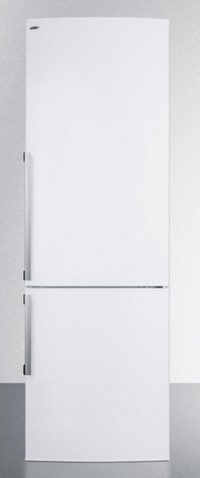
FFBF240WX $1390 |
Way back when (maybe 20+ years ago), a couple of
companies started importing these tall, slender, efficient
AC refrigerators; the manufacturer was Vestfrost of
Denmark, and these refrigerators were sold under a variety
of names, including ConServ, Eco-Fridge, and probably a few
others. Unfortunately, these Danish refrigerators have been
discontinued and are no longer being imported into this
country, but there are other efficient options available,
with the same attractive European styling – and also Energy
Star rated and frost-free. If you are looking for a quiet,
efficient refrigerator with a small footprint, check out our
offerings at
www.eco-fridge.com. The model to the left is
all-white, and the model to the right offers stainless doors
with matching platinum sides, and have a 2’ x 2’ foot-print
to fit in a small space. The refrigerators, above, are 9.65 cu.ft. capacity; there are two other models available in
white or with stainless doors that are 27.5” wide and 13.8
cu.ft capacity total, if you need more fridge space. The
interior color on all models is white; call for freight
costs and more information. They use 1 to 1.2 kWh a day,
depending on temps. |
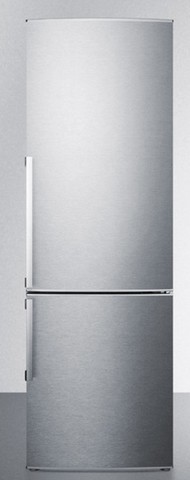
FFBF245SSX $1489 |

GOOD NEWS: The federal Investment Tax Credit
(ITC) has been extended for another five years, so we
anticipate the solar industry will continue its phenomenal
growth during this time. BUT, some utility regulators are
fighting back on certain levels…like charging higher
net-metering rates for their customers who have installed
solar power systems.
The impact of the ITC will vary from state to state. Changes
were already underway in many leading solar states, such as
California, before the ITC extension was passed. California
recently proposed keeping retail rates the same for
residential solar customers at present, but with some modest
changes. Hawaii has halted new net energy metering
applications and introduced two new tariffs as replacements.
Nevada has gone the furthest after its recent decision to
end net metering for new and existing customers.
Some utilities feel that customers opting for a grid-tied
solar system get an unfair rate reduction (since non-solar
customers may potentially pay more for the grid power than
for those with solar)–even though those solar people have
opted to make a major investment in a photovoltaic (PV)
system. Some utilities and co-ops are raising their monthly
rates for a variety of reasons: to account for lost revenue,
or to impact electrical load growth and peak electrical
demand. But now that the ITC has been extended, solar is
here to stay – and it is anticipated that an additional 25
gigawatts of PV (solar capacity) will be installed within
the next 5 years.
The ITC extension is a great boost to the solar industry,
and some states are eagerly pursuing clean energy
production…including Minnesota, with its value-of-solar
tariff that will promote PV in a big way (for more
information visit
http://www.greentechmedia.com/articles/read/minnesotas-great-leap-into-solar-begins).
These are the best of times, and the worst of times! In most
states, the Public Service Commissions or Public Utility
Commissions answer to the legislature, so vote wisely and
attend your electrical co-op meetings, if you want these
clean energy trends, net metering benefits, and reasonable
power rates to continue. |
| |
| Let us not seek the Republican
answer or the Democratic answer, but the right answer. Let
us not seek to fix the blame for the past. Let us accept our
own responsibility for the future. --J.F. Kennedy |
|
|
|
You can become an energy detective
with your Killawatt™ Meter!
If you are trying to keep a lid on your electric bill, it’s
most helpful to determine what your electrical loads are on
certain devices. Is your refrigerator really an energy hog?
How much more juice does your PC use than your laptop? This
device is a simple way to determine your electrical usage.
You plug it into a wall socket (or perhaps onto an extension
cord, to make it easier to read) and plug your appliance or
device into it. It will give you instantaneous readings on
voltage, watts, amps, and frequency (hertz) numbers. It also
gives you cumulative data—so you can see how much power your
‘fridge pulls in a week. If you plug your refrigerator into
it, it should cycle and give a higher figure from time to
time—that means your compressor is running then.
These are still a great deal at $25 plus shipping! |
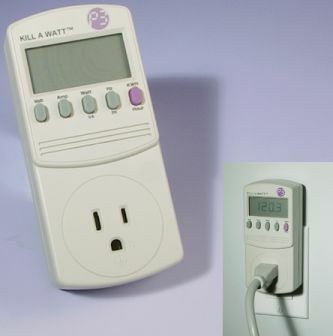 |
|
WATER PUMPING IN HAITI!
When people work together, great things happen! |
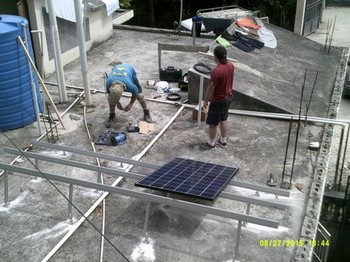 |
|
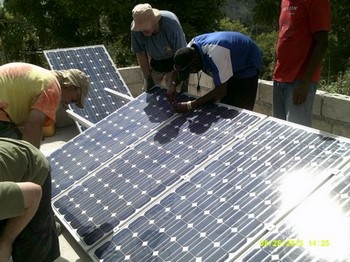 |
|
above: customer Todd Rosen and helpers
assemble the system
Last summer we worked with some very special people,
with the goal of providing clean water from a well to a
people desperately in need – the small mountain community of Gris Gris in southern Haiti. One of the main challenges of
this system was security; a concrete building was
constructed to house the components and water tanks, and
tamper-proof rails and hardware were installed to prevent
theft of the solar modules (which also made for easy
installation and good hurricane protection). The well is 550
feet deep and the pump hangs at 350 feet deep, and pumps
about 1200 gallons per day.
This system makes a long walk to the main well at the top of
the mountain unnecessary for many people; this walk takes an
hour for most people (and it is usually the women and
children who have to carry the 40 lb. buckets).
Clean water is one of the good things you can give a village
because of all the problems associated with contaminated
water. The water is sold for three cents for a five gallon
bucket. Our friends at Water For Life in Kalona, Iowa, who
work in Haiti, made the well possible.
Three spigots provide plenty of potable water,
and
the smiling faces tell it all! |
|
“People say walking on water is a miracle, but to
me, walking peacefully on earth is the real miracle.”
–Thich Nyat
Hahn
|
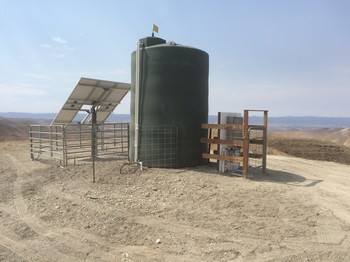 Solar water pumping is a very neat and relatively
simple technology. We provide water solutions in deserts and
jungles, for ranches, gardens, remote homes, for clinics, schools
and villages in other countries. Our pump systems help people,
crops, livestock and even fish and other wildlife! The system at
left is for one of our California customers, and it provides water
for his ~300 head of cattle. Visit us now online at
www.PVsolarpumps.com — fill out the questionnaire and we’ll propose
a system for your project. Solar water pumping is a very neat and relatively
simple technology. We provide water solutions in deserts and
jungles, for ranches, gardens, remote homes, for clinics, schools
and villages in other countries. Our pump systems help people,
crops, livestock and even fish and other wildlife! The system at
left is for one of our California customers, and it provides water
for his ~300 head of cattle. Visit us now online at
www.PVsolarpumps.com — fill out the questionnaire and we’ll propose
a system for your project.
The Chinook
is back!
Something new is blowing in the wind….our
popular 200W CHINOOK Wind Turbines were discontinued a while back,
but they are once again in production, and for a limited time will
still be available at the old price of $675 plus
shipping. This is available as a 12V or 24V battery charging model,
and it comes with its own controller. The Chinook folks are in
corroboration with Midnite Solar, and a 500W and 1 KW model should
be available soon (hopefully by autumn?) as a 12, 24 or 48V battery
charging model OR straight grid-tie (with no batteries). We really
don’t have much information on the larger wind gennies at this
point; they are still in the testing phase. As soon as these become
available we will be offering them. Stay tuned for more information!

FREE SEED! Last year we had a fine APRICOT crop.
This particular variety is called Sweet Pit Apricot, as this tasty
fruit contains a very edible almond. I have some pits to give away
if you wish to grow your own (it’s not difficult); send stamps. You
must be in a location that has winter; they need a cold spell, and
are native to where there are long cold winters and short hot
summers. Since they make the envelope more than 1/4” thick, the P.O.
considers this a package–and it’s $2.54 for postage in the U.S. I
also have some short-season hot cayenne peppers… I will send
instructions! |
 |

BATTERIES. While solar modules may be the lifeblood of a PV system,
and inverters the ‘brain’, batteries are still the only way to get
back-up power, and hence they are considered the heart of the system
(although due to their general toxicity, they are sort of the
malignant side of these technologies!). There are many types of
batteries available and it can be confusing as to what best may suit
your needs.
Flooded lead acid cells (FLA) are most commonly used,
and are generally the best bang for the buck. They are readily
available in a variety of sizes; there are cheap batteries that may
only last a couple of years, mid-size models that will last 6 to 12
years, and awesome industrial cells that will last 20 to 25 years –
all based on proper care, of course, and how much you are willing to
spend up front. Pros: readily available, the technology is
well-understood and has changed little in over 100 years; they are
recyclable. Cons: the electrolyte is toxic and spillable; they
outgas hydrogen sulfide when charging and so must be vented in some
fashion; they absolutely require regular maintenance including
proper charging (and equalizing) and adding distilled water. At this
time, these kinds of batteries are what we generally specify for
most of our battery-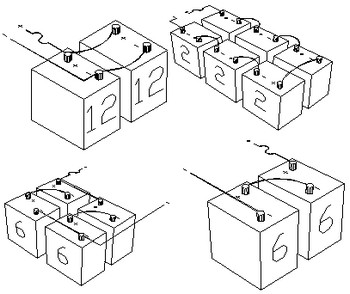 based systems. They are temperature sensitive
and need to be kept from freezing, as well as kept from excessively
hot temperatures (batteries tend to like similar temperatures as we
do). Car batteries are FLA, but they have thinner, multiple lead
plates to give up their ampacity in a burst (as for starting a
vehicle). Deep cycle batteries have fewer thicker plates to give up
their power over a longer period of time. based systems. They are temperature sensitive
and need to be kept from freezing, as well as kept from excessively
hot temperatures (batteries tend to like similar temperatures as we
do). Car batteries are FLA, but they have thinner, multiple lead
plates to give up their ampacity in a burst (as for starting a
vehicle). Deep cycle batteries have fewer thicker plates to give up
their power over a longer period of time.
AGM or absorbed glass mat
technologies are similar to FLA cells but they contain no liquid
electrolyte so they are safe for air transport and can even be
stacked sideways for ease of installation. They have similar
charging parameters as FLA batteries. Pros: they are
maintenance-free and do not outgas; they work indoors and also
outdoors in extremes of temperatures (and are recyclable). Cons:
they are considerably more costly than their liquid counterparts and
their cycle life is shorter. They are often the battery of choice,
though, in circumstances where no maintenance can be performed (as
in remote telecommunication repeater sites, area lighting, traffic
control, navigation aids or for powering telemetry equipment). Gel
cell batteries are similar to AGM technologies (as they are non-spillable)
but they generally do not take as high a charge as FLA or AGM
batteries; most solar charge regulators offer a separate control to
select what type of battery you have in your system, so it will
charge appropriately. Extreme of temperatures can damage AGM and gel
cells.
NiCad (Nickel Cadmium) batteries are occasionally but rarely
used in solar power systems; they do offer decent cycle life and
good performance in low temps, and they can deliver high capacity in
a short period of time, but they are more costly than FLA batteries
and the cells have a high discharge rate; therefore they also
require additional charging and are more toxic in their disposal.
NiFe (Nickel Iron or Edison) batteries are rather costly; they tend
to be long-lived and will tolerate a fair amount of abuse (like
overcharging, overdischarge); due to its low specific energy, poor
charge retention, and high cost of manufacture, other types of
rechargeable batteries have displaced the nickel-iron battery in
most applications.
LiOn (Lithium Ion) batteries were originally
popular in consumer electronics; they are known for their good
storage capacity and small size. Chemistry, cost, safety and
performance characteristics vary widely across LiOn types.
Recent applications include EVs (electric vehicles); Elon Musk of
Tesla fame has said his new “Powerwall” (the battery from their EV)
will be a major game changer in the world of residential battery
storage. However, at this writing it is not quite ready for prime
time; the battery pack is a 400V unit, and holds 7 kWh of storage
(their future off-grid model says it will offer 10kWh of storage).
There is no inverter yet that will play nicely with the “Powerwall”
but we shall likely see something later this year. Lithium ion
batteries can be quirky and even dangerous under some conditions, as
their electrolyte is flammable and under pressure. Hence, charging
parameters must be strictly controlled, or ‘thermal runaway’ may
occur–basically a fire. There have been battery recalls by some
companies. Even so, with its deep cycling possibilities, good
storage capacity (with low self-discharge rate) and smaller size, we
anticipate it will be available soon for UPS and off-grid
applications. However, we have learned it’s oft times better to let
someone else be the ‘beta tester’ for a new technology!
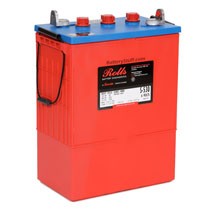 How do you determine the size of your battery bank? Well, we go back
to some of that basic math from earlier in the newsletter. First, we
need to know how many watt-hours (or kilowatt hours) a day are
needed. Suppose you wish to be able to run your (efficient)
refrigerator, radio and a few lights in the event of a power
failure. You’ve tallied up your loads, and you come up with 1500
watt-hours (or 1.5kWh) per day needed, and you want three days of
battery back-up. First thing is that batteries, inverters, and the
rest of the components are not 100% efficient, so we need to include
a load correction factor; so we multiply your 1500W times 1.4, and
get 2100 – the How do you determine the size of your battery bank? Well, we go back
to some of that basic math from earlier in the newsletter. First, we
need to know how many watt-hours (or kilowatt hours) a day are
needed. Suppose you wish to be able to run your (efficient)
refrigerator, radio and a few lights in the event of a power
failure. You’ve tallied up your loads, and you come up with 1500
watt-hours (or 1.5kWh) per day needed, and you want three days of
battery back-up. First thing is that batteries, inverters, and the
rest of the components are not 100% efficient, so we need to include
a load correction factor; so we multiply your 1500W times 1.4, and
get 2100 – the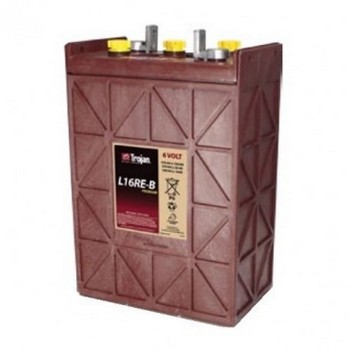 actual watts we have to make to get your 1500
watt-hours needed. We take 2100 X 3 (the number of days of back-up
desired), then take that number times 2 (for 50% depth of
discharge–we never want to take the batteries below that) and come
up with 12600; then divide THAT by your system voltage (usually 24V
or 48V) and that gives us the number of amp-hours of storage needed.
So for a 24V system, you would need 535 amp-hours of storage at 24V.
Are you confused as can be? Visit our battery page at
www.oasismontana.com/batteries.html for more dull information or
give us a call and we’ll help confirm what you need for the loads
you wish to run! 406-777-4309. actual watts we have to make to get your 1500
watt-hours needed. We take 2100 X 3 (the number of days of back-up
desired), then take that number times 2 (for 50% depth of
discharge–we never want to take the batteries below that) and come
up with 12600; then divide THAT by your system voltage (usually 24V
or 48V) and that gives us the number of amp-hours of storage needed.
So for a 24V system, you would need 535 amp-hours of storage at 24V.
Are you confused as can be? Visit our battery page at
www.oasismontana.com/batteries.html for more dull information or
give us a call and we’ll help confirm what you need for the loads
you wish to run! 406-777-4309. |

RENEWABLE ENERGY NEWS BITES:
>>>Fossil fuels - is the decline permanent for the industry?
http://cleantechnica.com/2015/07/20/the-fossil-fuel-energy-industry-is-now-entering-terminal-decline/
Looks like the industry players will get less and less financially
feasible as time goes on.
>>>Declining Prices for Wind & Solar Are Impacting Capacity Factors
for Fossil Fuel Generation:
http://www.bloomberg.com/news/articles/2015-10-06/solar-wind-reach-a-big-renewables-turning-point-bnef
Once a solar or wind power facility is built, the marginal cost of
its electricity is pretty much zero–free electricity – while coal &
gas plants require more fuel for every watt produced! If you’re a
power company with a choice, you choose free every time.
>>> Turning pollution into printer ink:
http://www.takepart.com/article/2015/10/12/press-print-air-pollution?cmpid=tpdaily-eml-2015-10-12
>>>The most and least energy efficient states:
http://www.takepart.com/article/2015/10/06/most-and-least-energy-states?cmpid=tpdaily-eml-2015-10-6
You might be surprised to see where your state ranks; warmer and
colder states have different ways of ranking their efficiency.
>>>Over $650 Million in Savings Possible on Montana Electric Bills
by Growing Wind Energy: Montana could save over $650 million by 2050
and be a major power exporter.
http://www.awea.org/MediaCenter/pressrelease.aspx?ItemNumber=7966
According to the newly released data generated by using the U.S.
Department of Energy’s new 2015 report "Wind Vision: A new era for
wind power in the United States," low-cost wind can save Montana
consumers over $650 million on electricity bills through 2050. The
new data shows Montana can obtain over 400 percent of its
electricity from wind power by 2030 - enough energy to power 6.4
million American homes every year. Growing wind will not only lower
consumer electricity bills, it will also become an energy export for
the state (and help other states maintain their RE portfolios).
Other added economic benefits for the state would include $126.13
million dollars in annual property tax revenue and Montana
landowners would be paid by wind farm owners $51.14 million in lease
payments a year by 2030.
>>>The Best and Worst States for Solar:
http://www.marketwatch.com/story/the-best-and-worst-states-for-solar-2016-01-27
and
http://www.irecusa.org/2016/01/irec-and-vote-solar-release-2015-freeing-the-grid
Vote Solar and the Interstate Renewable Energy Council have released
the 2015 grades for "Freeing the Grid," an annual report card that
rates all 50 states on two key clean energy policies: net metering
and interconnection standards. In 2015, six states improved their
net metering grades. In total, more than two-thirds of U.S. states
now qualify for good ‘A’ or ‘B’ grades in this important clean
energy policy. On the flip side, four states received lower grades,
including the one-time rooftop solar leader Nevada, which fell to an
‘F’ grade as a result of recent policy decisions that drastically
change the value proposition for solar customers. Five states –
Hawaii, Illinois, Mississippi, New Hampshire and North Carolina –
improved their interconnection grades in 2015. Only one, North
Dakota, received a lower grade. Half of U.S. states have good ‘A’ or
‘B’ grades, and the remaining need improvement.
>>>Thinking about a residential wind turbine? Think again.
http://solartoday.org/2016/01/what-matters-when-shopping-for-a-small-wind-turbine/
Mick Sagrillo (industry expert) has some words of advice for you.
Benefits from state renewable portfolio standards
far outweigh costs:
http://www.greentechmedia.com/articles/read/report-benefits-from-state-renewable-portfolio-standards-outweigh-costs?utm_source=Solar&utm_medium=Newsletter&utm_campaign=GTMSolar
Opponents of renewables say they increase costs for
consumers, but studies indicate costs are far outweighed by
environmental and health improvements that come from 'greeing'
the energy mix.
Elon Musk says 'oil dependency is just stupid:
https://www.dailykos.com/story/2015/03/27/1373757/-Tesla-s-Elon-Musk-simplifies-how-dumb-our-oil-dependency-is?detail=emailclassic
An interesting article on methane and ruminants:
https://www.organicconsumers.org/news/ruminants-and-methane-not-fault-animals
Data Centers Could
Consume Three Times as Much Energy in Next Decade:
http://www.independent.co.uk/environment/global-warming-data-centres-to-consume-three-times-as-much-energy-in-next-decade-experts-warn-a6830086.html
Data centers have
mushroomed from virtually nothing 10 years ago to consuming
about 3 per cent of the global electricity supply and
accounting for about 2 per cent of total greenhouse gas
emissions. For perspective, the 416.2 terawatt hours of
electricity the world’s data centers used last year was far
higher than the UK’s total consumption of about 300 terawatt
hours. That gives it the same carbon footprint as the
airline industry. And this use will treble in the next
decade. Some internet companies – such as Facebook, Google
and Apple – are leading efforts to be more environmentally
responsible. The measures being taken include housing data
centers in cold climates – which dramatically reduces the
energy needed to cool the facilities – with a ready supply
of renewable energy. But at the moment the industry’s
environmental actions fall far short of what is needed.
Bats and Wind Turbines...the latest:
http://www.renewableenergyworld.com/articles/2016/01/bats-and-wind-turbines-moving-beyond-dracula.html
Who owns the sun? Things are getting
interesting...
http://www.bloomberg.com/features/2016-solar-power-buffett-vs-musk/?utm_source=Sailthru&utm_medium=email&utm_campaign=Issue:%202016-02-04%20Utility%20Dive%20Solar&utm_term=Utility%20Dive:%20Solar
By fighting rooftop solar, utilities are setting
themselves up for worse things to come:
http://www.vox.com/2016/2/3/10905624/utilities-rooftop-solar-storage
The Powerwall in a nutshell:
https://www.teslamotors.com/powerwall
Driven by Power
Outages and Savings, Towns Look to Microgrids:
http://bigstory.ap.org/article/60de3af523c142c586640b58af205d72/driven-power-outages-and-savings-towns-look-microgrid
The upstate New York town of
Nassau near Albany, which repeatedly found itself without
power for days during a string of storms, is planning to
pull its municipal buildings entirely off the electric grid
and to rely on solar, wind, landfill gas and battery storage
by 2020. The decision puts the town of 5,000 on the leading
edge of a national campaign to develop "microgrids" designed
to make communities more energy independent and the grid
more resilient. Similarly, A year ago, Fairfield,
Connecticut, hooked up an off-the-grid system that
automatically takes over if the utility grid fails. Built
with the help of a $1.1 million state program, Fairfield's
system combines a natural gas-powered generator and solar
panels at the emergency shelter and fire station, which are
connected to each other, the police station and cell phone
towers. A similar system is in the works at Fairfield's
waste water treatment plant. "Campus microgrids" are
familiar at places like hospitals and industrial plants, but
development of the more sprawling "community microgrids" has
been slowed by technical and regulatory hurdles. There's
also been a mixed response from utility companies, ranging
from resistance to a threat to their franchise to embracing
microgrids as a business opportunity.
Tesla's Powerwall hits the Australian market:
http://www.greentechmedia.com/articles/read/teslas-powerwall-is-out-in-australia?utm_source=Daily&utm_medium=Newsletter&utm_campaign=GTMDaily
|

Quotable quotes:
“Spring is the time of plans and projects.”
–Leo Tolstoy
“I love the smell of rain and growing things”
–Serina Hernandez
"The Democrats are the party of government activism, the party
that says government can make you richer, smarter, taller, and
get the chickweed out of your lawn. Republicans are the party
that says government doesn't work, and then get elected and
prove it."
—P.J. O'Rourke“The enemy isn’t conservatism. The enemy isn’t liberalism. The
enemy is bullshit."
—Lars-Erik Nelson
"I don't know whether it's the finest public housing in America or
the crown jewel of the federal prison system."
—Bill Clinton, on
life in the White House
"Outside of the killings, Washington has one of the lowest crime
rates in the country."
—Marion Barry, former Washington, D.C. Mayor
“Bees do have a smell, you know, and if they don't they
should, for their feet are dusted with spices from a million
flowers.”
— Ray Bradbury
"If the gods had intended for people to vote, they would have given
us candidates."
—Howard Zinn
Politics is supposed to be the second-oldest profession. I have come
to realize that it bears a very close resemblance to the first.
—Ronald Reagan
“Rest is not idleness, and to lie sometimes on the grass
under trees on a summer's day, listening to the murmur of
the water, or watching the clouds float across the sky, is
by no means a waste of time.”
---John Lubbock |
OASIS MONTANA INC., Stevensville, Montana, USA
406-777-4309 E-mail:
info@oasismontana.com
Please feel free to share this newsletter;
knowledge is power! |











 Solar water pumping is a very neat and relatively
simple technology. We provide water solutions in deserts and
jungles, for ranches, gardens, remote homes, for clinics, schools
and villages in other countries. Our pump systems help people,
crops, livestock and even fish and other wildlife! The system at
left is for one of our California customers, and it provides water
for his ~300 head of cattle. Visit us now online at
Solar water pumping is a very neat and relatively
simple technology. We provide water solutions in deserts and
jungles, for ranches, gardens, remote homes, for clinics, schools
and villages in other countries. Our pump systems help people,
crops, livestock and even fish and other wildlife! The system at
left is for one of our California customers, and it provides water
for his ~300 head of cattle. Visit us now online at


 based systems. They are temperature sensitive
and need to be kept from freezing, as well as kept from excessively
hot temperatures (batteries tend to like similar temperatures as we
do). Car batteries are FLA, but they have thinner, multiple lead
plates to give up their ampacity in a burst (as for starting a
vehicle). Deep cycle batteries have fewer thicker plates to give up
their power over a longer period of time.
based systems. They are temperature sensitive
and need to be kept from freezing, as well as kept from excessively
hot temperatures (batteries tend to like similar temperatures as we
do). Car batteries are FLA, but they have thinner, multiple lead
plates to give up their ampacity in a burst (as for starting a
vehicle). Deep cycle batteries have fewer thicker plates to give up
their power over a longer period of time.  How do you determine the size of your battery bank? Well, we go back
to some of that basic math from earlier in the newsletter. First, we
need to know how many watt-hours (or kilowatt hours) a day are
needed. Suppose you wish to be able to run your (efficient)
refrigerator, radio and a few lights in the event of a power
failure. You’ve tallied up your loads, and you come up with 1500
watt-hours (or 1.5kWh) per day needed, and you want three days of
battery back-up. First thing is that batteries, inverters, and the
rest of the components are not 100% efficient, so we need to include
a load correction factor; so we multiply your 1500W times 1.4, and
get 2100 – the
How do you determine the size of your battery bank? Well, we go back
to some of that basic math from earlier in the newsletter. First, we
need to know how many watt-hours (or kilowatt hours) a day are
needed. Suppose you wish to be able to run your (efficient)
refrigerator, radio and a few lights in the event of a power
failure. You’ve tallied up your loads, and you come up with 1500
watt-hours (or 1.5kWh) per day needed, and you want three days of
battery back-up. First thing is that batteries, inverters, and the
rest of the components are not 100% efficient, so we need to include
a load correction factor; so we multiply your 1500W times 1.4, and
get 2100 – the actual watts we have to make to get your 1500
watt-hours needed. We take 2100 X 3 (the number of days of back-up
desired), then take that number times 2 (for 50% depth of
discharge–we never want to take the batteries below that) and come
up with 12600; then divide THAT by your system voltage (usually 24V
or 48V) and that gives us the number of amp-hours of storage needed.
So for a 24V system, you would need 535 amp-hours of storage at 24V.
Are you confused as can be? Visit our battery page at
actual watts we have to make to get your 1500
watt-hours needed. We take 2100 X 3 (the number of days of back-up
desired), then take that number times 2 (for 50% depth of
discharge–we never want to take the batteries below that) and come
up with 12600; then divide THAT by your system voltage (usually 24V
or 48V) and that gives us the number of amp-hours of storage needed.
So for a 24V system, you would need 535 amp-hours of storage at 24V.
Are you confused as can be? Visit our battery page at
